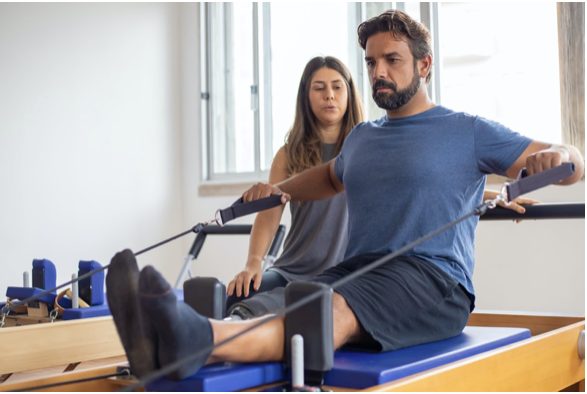
Pain can severely impact quality of life.
Whether your pain is temporary or chronic, managing it allows you to accomplish daily tasks and live a life you enjoy. And while your pain symptoms may have you considering prescription pain medication, it’s important to explore all options—especially ones less dangerous and addictive than opioids.
Why Should I Consider Non-Opioid Pain Treatment?
At the surface, taking a pill to manage pain seems like a quick solution. But opioids don’t always come without consequences.
In fact, up to to 12 percent of people using an opioid for pain develop a substance abuse disorder (1). Substance use disorder wreaks havoc on multiple areas of life, including physical health, mental wellness, finances, and close relationships. And it doesn’t take a lifetime to develop addiction—it can happen in just five days (2).
Though the science about these dangers is widespread, providers are still prescribing highly addictive pain medications at unsafe rates. Data shows enough prescriptions are written each year that half of all Americans could have one (3). This means that at five percent of the world’s total population, Americans are consuming 80 percent of the world’s opioid prescriptions.
As a patient in need of pain relief, sometimes the only thing standing between you and the door to addiction is your own voice. Knowing the risks, you have the power to advocate for your health and discuss options with a doctor. Working alongside a healthcare provider to manage pain without opioids may decrease your risk for developing a substance use disorder in the future.
Let’s explore non-opioid pain management methods and how they might work for you.
5 Ways to Manage Pain Without Opioids
There are many alternatives to managing pain without opioids. Here are five to consider:
Over-the-Counter Pain Management
Non-addictive medications like Acetaminophen (Tylenol®) or ibuprofen (Advil®) reduce pain and/or inflammation. These medicines are usually effective in managing mild to moderate pain. A recent study revealed that non-opioid medicines like acetaminophen and ibuprofen had the same effectiveness as opioids in reducing pain for patients in emergency rooms (4). Make sure to pay close attention to dosage instructions and ask a pharmacist or doctor about any drug reactions or health problems to consider before taking them.
Physical Therapy and Exercise
Physical therapy, and doctor-approved exercise, may help to treat the root cause of the issue causing pain symptoms. This is especially relevant if your pain is muscle or joint related. Physical therapy treats pain through targeted movements, improving patients’ strength, flexibility, and range of motion (5). While opioids mask symptoms, physical therapy and exercise offers individualized treatment for specific bodily ailments. You can explore this option by first talking to your doctor about recommended physical therapists in your area. Performing movements and exercise under the guidance of an expert will help to lower your risk for further injury.
Cognitive Behavioral Therapy
The Centers for Disease Control and Prevention suggest cognitive behavioral therapy for those suffering from chronic pain. CBT is talk therapy that helps create skills to change negative thought patterns and behaviors. In some cases, this type of therapy might not eliminate pain, but rather offers tools to alter emotional, behavioral, and physical responses to it (6). While you can start with referrals from a healthcare provider, you likely don’t need a doctor’s referral to find a therapist you can trust.
Acupuncture
A traditional part of Chinese medicine, acupuncture is a therapy in which thin needles are inserted through your skin at strategic points throughout your body. In modern medicine, acupuncturists insert needles in places that stimulate nerves, muscles, and connective tissues to leverage the body’s natural painkillers (7). Be sure to research an experienced, trained, and qualified acupuncturist in your area and discuss treatment with your doctor beforehand.
Massage
Massage is useful for more than just relaxation. Therapeutic massage helps reduce inflammation and increase blood flow in areas where pain persists. In doing so, massage therapists may help relax painful muscles, tendons, and joints while blocking pain messages sent to and from the brain (8). In addition to pain reduction, massage has positive effects on stress management and sleep—two areas that exacerbate pain if left unmanaged. You can start by talking with your doctor about massage for your pain management, and then research a licensed, experienced massage therapist in your community.
Managing Pain Without Opioids is Possible
If you’re interested in managing your pain without opioids, there are options for you. Talk with your doctor about a treatment plan that includes these non-opioid alternatives.
About Game Changer
Created in 2018, GameChanger is a student-powered movement with focus on substance misuse prevention among youths. We connect students, educators, and communities with education, training, coaching, and support services to prevent opioid and other drug use before it starts.
Visit our resources to learn more.
References
- Overdose Death Rates. National Institute on Drug Abuse. 20 January 2022.
- Opioid dependence can happen after just 5 days. Truth initiative. 23 October 2018.
- Mann, Brian. Doctors And Dentists Still Flooding U.S. With Opioid Prescriptions. NPR. 17 July 2020.
- Chang AK, Bijur PE, Esses D, Barnaby DP, Baer J. Effect of a Single Dose of Oral Opioid and Nonopioid Analgesics on Acute Extremity Pain in the Emergency Department: A Randomized Clinical Trial. JAMA. 2017;318(17):1661–1667. doi:10.1001/jama.2017.16190
- PHYSICAL THERAPY: A SAFE ALTERNATIVE TO OPIOIDS FOR PAIN MANAGEMENT. Texas Physical Therapy Association.
- Safely and Effectively Managing Pain Without Opioids. Centers for Disease Control and Prevention. 11 June 2021.
- Acupuncture. Mayo Clinic. 30 April 2022.
- Therapeutic massage for pain relief. Harvard Health. 01 July 2016.